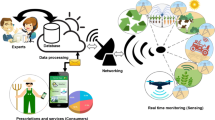Abstract
Wireless sensor networks (WSNs) have great potential to revolutionize many science and engineering domains. We present a novel environmental monitoring system with a focus on overall system architecture for seamless integration of wired and wireless sensors for long-term, remote, and near-real-time monitoring. We also present a unified framework for sensor data collection, management, visualization, dissemination, and exchange, conforming to the new Sensor Web Enablement standard. Some initial field testing results are also presented. The monitoring system is being integrated into the Texas Environmental Observatory infrastructure for long-term operation. As part of the integrated system, a new WSN-based soil moisture monitoring system is developed and deployed to support hydrologic monitoring and modeling research. This work represents a significant contribution to the empirical study of the emerging WSN technology. We address many practical issues in real-world application scenarios that are often neglected in the existing WSN research.














Similar content being viewed by others
References
Culler, D., Estrin, D., & Srivastava, M. (2004). Overview of sensor networks. IEEE Computer, 37, 41–49.
Martinez, K., Hart, J. K., & Ong, R. (2004). Environmental sensor networks. IEEE Computer, 37, 50–56.
Mainwaring, A., Polastre, J., Szewczyk, R., Culler, D., & Anderson, J. (2002). Wireless sensor networks for habitat monitoring. In Proceedings of the ACM international workshop on Wireless Sensor Networks and Applications (WSNA).
MoteLab. Harvard sensor network testbed. Available at http://motelab.eecs.harvard.edu
ExScal. Extreme scale wireless sensor networking. Available at http://cast.cse.ohio-state.edu/exscal
Kansei. Sensor testbed for At-scale experiments. Available at http://ceti.cse.ohio-state.edu/kansei
CitySense. An open, urban-scale sensor network testbed. Available at http://www.citysense.net
SCADDS. Scalable coordination architectures for deeply distributed systems. Available at http://www.isi.edu/scadds/testbeds
Texas Environmental Observatory. Available at http://www.teo.unt.edu
Cheng, S., & Wang, R. (2002). An approach for evaluating the hydrological effects of urbanization and its application. Hydrological Processes, 16, 1403–1418.
Sensor Web Enablement WG., Open Geographic Consortium Inc. Available at http://www.opengeospatial.org.
Crossbow Inc. Available at http://www.xbow.com
Harrington, B., Huang, Y., Yang, J., & Li, X. (2009). Energy-efficient map interpolation for sensor fields using Kriging. IEEE Transactions on Mobile Computing, 8(5), 622–635.
Ye, W., Heidemann, J., & Estrin, D. (2002). An energy-efficient MAC protocol for wireless sensor networks. In Proceedings of the 21st international annual joint conference of the IEEE Computer and Communications Societies (INFOCOM) (Vol. 3, pp. 1567–1576).
Stallings, W. (2004). Wireless communications & networks, 2nd edn. Prentice Hall.
van Dam T., & Langendoen, K. (2003). An adaptive energy-efficient MAC protocol for wireless sensor networks. In Proceedings of the international conference on Embedded Networked Sensor Systems (SenSys).
Polastre, J., Hill, J., & Culler, D. (2004). Versatile low power media access for wireless sensor networks. In Proceedings of the international conference on Embedded Networked Sensor Systems (SenSys).
Rhee, I., Warrier, A., Aia, M., & Min, J. (2005). Z-MAC: A hybrid MAC for wireless sensor networks. In Proceedings of the international conference on Embedded Networked Sensor Systems (SenSys).
Musaloiu-E, R., Terzis, A., Szlavecz, K., Szalay, A., Cogan, J., & Gray, J. (2006). Life under your feet: A wireless soil ecology sensor network. In Proceedings of the third workshop on Embedded Networked Sensors (EmNets).
Cardell-Oliver, R., Smettem, K., Kranz, M., & Mayer, K. (2005). A reactive soil moisture sensor network: Design and field evaluation. International Journal of Distributed Sensor Networks, 1(2), 149–162.
Maroti, M., Kusy, B., Simon, G., & Ledeczi, A. (2004). The flooding time synchronization protocol. In Proceedings of the ACM conference on Embedded Networked Sensor Systems (SenSys).
Woo, A., Tong, T., & Culler, D. (2003). Taming the underlying challenges of reliable multihop routing in sensor networks. In Proceedings of the international conference on Embedded Networked Sensor Systems (SenSys).
Technologic Systems Inc. Available at http://www.embeddedarm.com
SensorML, UAH VAST. Available at http://vast.uah.edu/SensorML
Google Maps API, Google. Available at http://code.google.com/apis/maps/
Keyhole Markup Language, Google. Available at http://code.google.com/apis/kml
Delicato, F. C., Pires, P. F., Pinnez, L., Fernando, L., & da Costa, L. F. R. (2003). A flexible web service based architecture for wireless sensor networks. In Proceedings of the 23rd international conference on distributed computing systems workshops.
Zhang, J., Hart, Q., Gertz, M., Rueda, C., & Bergamini, J. (2009). Sensor data dissemination systems using Web-based standards: A case study of publishing data in support of evapotranspiration models in California. Civil Engineering and Environmental Systems, 26(1), 35–52.
Garcia, R. M., Carvalhal, P., Ferreira, M. J., Silva, L. F., Almeida, H., Santos, C., et al. (2009). A flexible framework for data exchange and presentation between wireless sensor networks and personal devices. In The international conference on “Computer as a Tool”.
Sleman A., & Moeller, R. (2008). Integration of wireless sensor network services into other home and industrial networks using device profile for web services (DPWS). In The 3rd international conference on Information and Communication Technologies: From Theory to Applications (ICTTA).
Kawahara, Y., Kawanishi, N., Ozawa, M., Morikawa, H., & Asami, T. (2007). Designing a framework for scalable coordination of wireless sensor networks, context information and web services. In The 27th international conference on Distributed Computing Systems Workshops (ICDCSW).
52North Sensor Web, 52north.org. Available at http://52north.org/
Metro Web Services, Sun Microsystems, Inc. Available at http://java.sun.com/webservices/
NovaLynx Corporation. Power budget calculations. Available at http://www.novalynx.com
Acknowledgements
This work is supported in part by the National Science Foundation of the United States under Grants OCI-0636421, CNS-0709285, and EEC-0431818 and by the Texas Advanced Research Program under Grant 003594-0010-2006. The authors would like to thank David Hunter (City of Denton), Sonny Solis (Texas Parks and Wildlife), Bob Carle (National Weather Service), Wilfredo Franco (ULA), and members of the TEO Research Group at UNT, especially Rudi Thompson (Biology), Duane Gustavus (CITC), Adam Skelton (EE MS student), Sanjaya Gurung (EE MS student), and Liping Chen (Applied Geography MS student) for their contributions to the development of the TEO system.
Author information
Authors and Affiliations
Corresponding author
Rights and permissions
About this article
Cite this article
Yang, J., Zhang, C., Li, X. et al. Integration of wireless sensor networks in environmental monitoring cyber infrastructure. Wireless Netw 16, 1091–1108 (2010). https://doi.org/10.1007/s11276-009-0190-1
Received:
Accepted:
Published:
Issue Date:
DOI: https://doi.org/10.1007/s11276-009-0190-1




